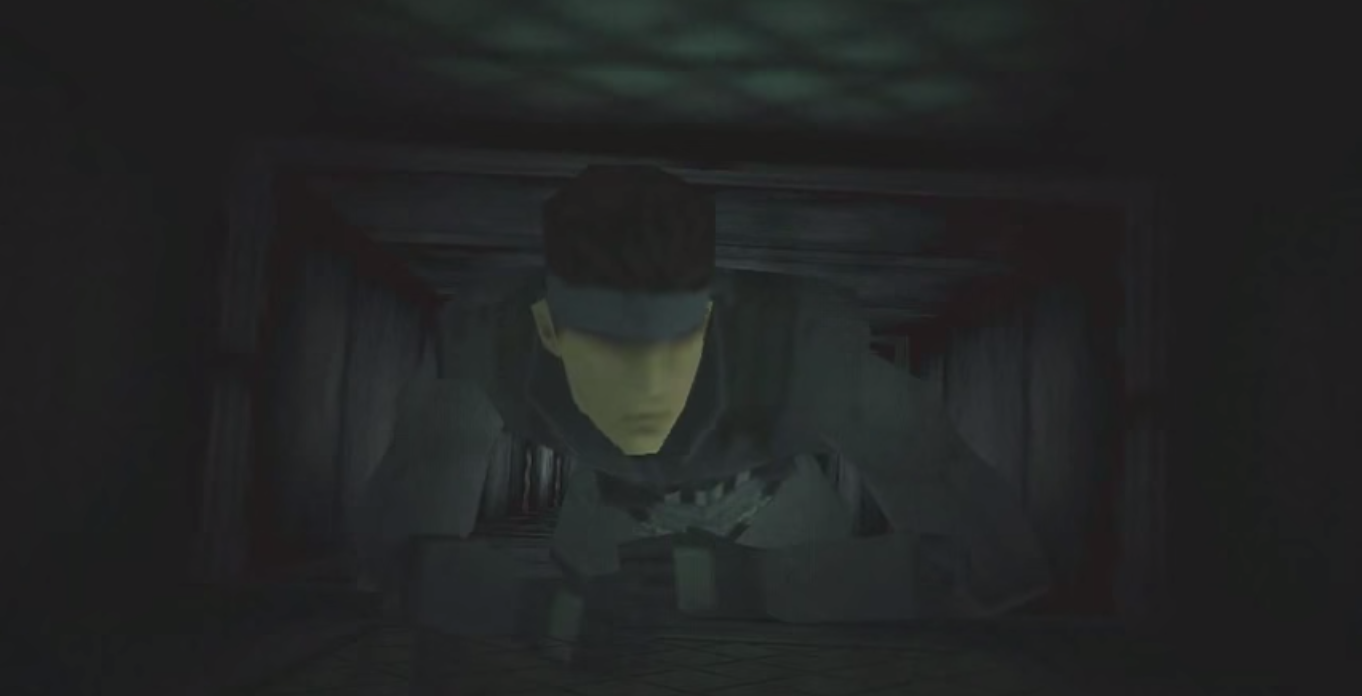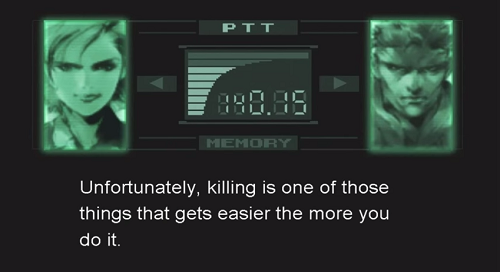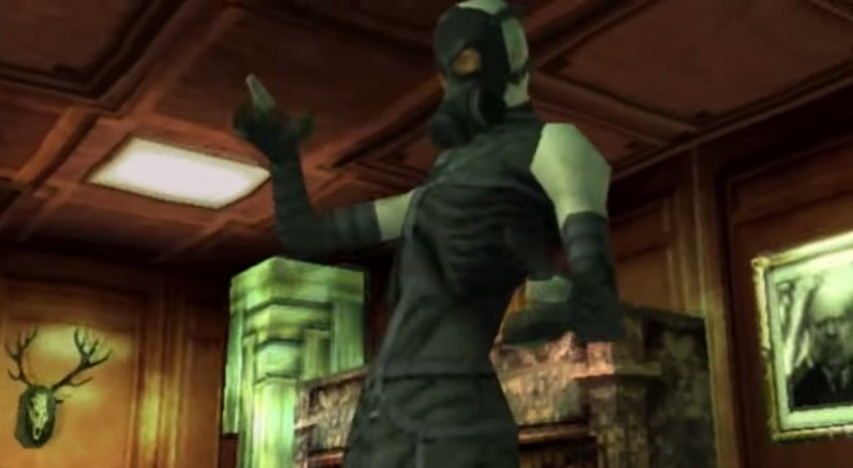The Metal Gear video game franchise has a reputation for excellence in storytelling and innovative gameplay. It is also comically difficult. Join Deadshirt Editor-in-Chief and absolutely terrible video gamer Dylan Roth as he plays through the entire Metal Gear canon in anticipation of the long-awaited Metal Gear Solid V: The Phantom Pain, out this fall.
As much as I enjoyed the first two installments of SNAAAAAAAKE!, playing through and analyzing the original Metal Gear games was really always just build-up to this review. The past few weeks have been dedicated to examining how my experience playing Metal Gear Solid worked for or against its predecessors—now it’s time to get into Metal Gear Solid itself, the groundbreaking game that introduced American players to the world of Solid Snake, FOXHOUND, Big Boss, and Revolver Fucking Ocelot.
Metal Gear Solid is a 3D stealth action game that’s 40% sneaking around, 30% combat, and 30% cutscenes. Originally released for the PlayStation in 1998, Metal Gear Solid features a twisty-turny spy-fi plot, complex characters, and creator Hideo Kojima’s trademark off-kilter metatextual sense of humor. While the game is famous for its filmic elements (the fifth generation of gaming was the first opportunity for console games to really experiment with cinematic storytelling), Metal Gear Solid is still heart and soul a video game, lovingly adhering to and subverting classic game structure and tropes.
I first played Metal Gear Solid as a preteen in my cousin’s basement, though I would say that my love for the game didn’t come from playing it (I was so godawful that I don’t think I ever got past the first boss on my own) as much as watching my cousins play through the story. I’d never before experienced a video game so complex and confusing to my eleven-year-old brain. Metal Gear Solid was my first “grown-up” video game, and even though over a decade passed between my first exposure to it and my first solo play-through, I could still clearly recall many of its striking cinematic images and memorable dialogue.
I should forewarn you that, unlike the rest of the games in the series, playing through Metal Gear Solid for this review was a very nostalgic experience for me, and that may paint my analysis a bit. I played Metal Gear Solid in its classic PSOne form, purchased as a download from the Playstation store on my PS3. While there is no official HD version of this game, it was faithfully remade for the GameCube in 2004 as Metal Gear Solid: The Twin Snakes, totally re-created with better graphics in widescreen, and incorporating gameplay elements from Metal Gear Solid 2: Sons of Liberty. This version is not available on Nintendo’s Virtual Console, and the disc sells for upwards of $60 online, so a digital download of the PSOne version is your best bet if you want to play the game for yourself. (The download is also included in the Metal Gear Solid Legacy Collection, along with its companion game VR Missions which I won’t be covering here because it’s basically just a ton of bonus stages with no story.) If you just plan to watch the game on YouTube, however, I definitely recommend the remake because it’s much prettier.
Alright, the time has come—let’s crawl into our cardboard boxes and talk about Metal Gear Solid.
Story
Plucked out of retirement yet again, legendary mercenary Solid Snake (voiced by David Hayter) is recruited by an American black ops unit to infiltrate a nuclear waste disposal facility on the awesomely named Shadow Moses Island that’s been taken over by a new incarnation of his former unit, FOXHOUND. His mission is to rescue two high-profile hostages and disable yet another nuclear armed walking battle tank: Metal Gear REX. Sounds pretty familiar to anyone who’s played the previous Metal Gear games…except nothing about Snake’s mission is what it seems.
SPOILERS AHEAD
As always, Snake is alone in the field but backed up by a team of experts accessible via transmitter (in this case the Codec device, which stimulates the small bones in your ear to create sound only you can hear, which remains one of the coolest things ever). Unlike previous games, however, your intelligence team is made up of fleshed-out, complicated characters performed by talented voice actors like Jennifer Hale and Kim Mai Guest. They play a more active role in the plot, and you get to know them a lot better. There’s also more of a supporting cast of characters you meet while on Shadow Moses, like rookie commando Meryl Silverburgh and nebbish engineer Hal “Otacon” Emmerich. The villains are equally memorable, expanding their boss battle combat mechanics into full-on supervillain gimmicks. Some of the bad guys are genuinely sympathetic, and some of the more heroic characters are totally despicable.
The character development is split evenly between animated cutscenes and conversations via Codec. Most of it is highly improbable—Snake is on a crucial mission to prevent World War III, but he still takes the time to hold lengthy heart-to-hearts over the radio while hiding in an air vent or just standing around, and villains have a habit of delivering long expository speeches in their final seconds minutes hours between being defeated and bleeding out. Even Snake, who up to this point has been a pretty generic Badass Protagonist, has to confront some real personal challenges and grow as a person.
The most prominent theme of Metal Gear Solid is one of nature vs. nurture, as Snake confronts the truth about his origins—he is, in fact, a genetically engineered clone of Big Boss, the legendary mercenary-turned-supervillain from the first two Metal Gear games. Snake’s been created to be the ultimate soldier, but he isn’t the only one. The villain of MGS is Snake’s evil twin, Liquid Snake, who shares their father’s goal of perpetual war. Liquid was created using the recessive genes discarded to create Solid Snake, and resents his favored brother. But while Liquid is without question an evil mass-murdering bastard, he also seeks to cure himself and his family of genome soldiers (also enhanced with Big Boss’s genes) of the genetic defects that will eventually kill them.
SPOILERS TO FOLLOW.
As with the previous games, the true villain of Metal Gear Solid is the military industrial complex. The US and their private contractors are dead set on continuing to build bigger and deadlier weapons like Metal Gear REX, which is designed very specifically to circumvent the terms of the real-life START 1 disarmament treaty between the US and Russia. The shadowy masterminds behind Solid Snake’s mission resort to some absolutely gruesome tactics to keep their secrets hidden. Snake believes that he’s been sent to rescue the chief of DARPA (the real-life agency that develops advanced defense tech) and the president of contractor Armstech, but he’s actually been sent to kill them. Snake has been unknowingly injected with FOXDIE, an advanced virus which targets specific individuals. At the end of the game, Liquid Snake also succumbs to FOXDIE, meaning that since Solid Snake is genetically similar, it will likely kill him, too—it’s just a matter of when.
Metal Gear Solid is also critical of how poorly the nuclear superpowers dispose and safeguard their nuclear waste. Hideo Kojima hammers these points home by cutting to real-life full motion video clips when referring to contemporary problems, to remind you, the player, that not every villain in the game is imaginary. Characters frequently refer to advanced weapons or espionage tech in the game being “made from currently existing technology,” which seems to be a nod to the player that it’s not as far fetched as it seems.
Nearly every character laments the futility of violence and war at some point in the game. If they don’t, that’s how you know they’re really evil.
Gameplay
Metal Gear Solid further refines the stealth-based action gameplay of Metal Gear 2: Solid Snake, focusing on sneaking, hiding, and avoiding combat as you traverse (say it with me now, it’s delicious) Shadow Moses Island. There’s less emphasis on puzzles and more on story and combat than in the previous game, but the core principles are essentially the same, and that’s not a bad thing. The boss battles are each unique, there’s a reason to make use of all the different weapons and pieces of equipment provided, and the difficulty curve is pretty manageable up until the last chapter.
Metal Gear Solid is excellent on a lot of levels, but I’d be lying if I said it was a dream to play. There are a lot of great innovations present—the cover system in MGS is still more or less in use today, for example—but in a lot of ways Metal Gear Solid feels like an awkward transition between its 2D predecessor and its 3D sequel, Metal Gear Solid 2: Sons of Liberty. Everything that worked about Metal Gear 2 works here, but some of the elements designed to take advantage of the 3D environment are kind of a pain.
With the exception of the sniper rifle and stinger missiles, there is no first-person shooting mode, which often makes aiming your weapon frustrating. (First-person shooting would be added in MGS2, and retroactively into The Twin Snakes.) Most of the game plays most easily using the digital directional buttons, but aiming the sniper rifle or stinger missiles is downright impossible without an analog stick, which early PlayStation adopters may not have even had yet. (The Dual Analog controller had just been released in 1997 to replace the original pad-only controller.) The camera usually follows you from above, but certain rooms use a stationary camera, and adjusting to this sometimes means that you have to change stick/pad direction in order to continue moving in a straight line.
Metal Gear Solid is also a real challenge, and at times goes beyond the level of difficulty that I find enjoyable to play. For instance, I spent days trying to defeat Metal Gear REX—trying new strategies, consulting online walkthroughs—before finally giving up and watching the last hour of the game (which is mostly cutscenes anyway) on YouTube. Turns out I had failed to pick up body armor at some now-inaccessible point in the story, and it’s just about impossible to survive the fight with REX without equipping it. The experience might have been less frustrating if I hadn’t needed to begin the multi-part battle from the beginning each time, and sit through a handful of unskippable in-game cutscenes halfway through.
I do have to give MGS a lot of credit for poking fun at itself for being a frustrating game, and for doing so in some very creative ways. Metal Gear Solid has one of the most famously nonsensical boss battles of all time: in order to defeat Psycho Mantis, a mind-reader who can predict your every move, you have to unplug your controller from port 1 and plug it into port 2, thus making you unreadable. There is no reason you would think to do that, other than someone suggesting it to you, which Colonel Campbell eventually does, usually after you’ve already been killed a couple of times. He’ll just flat-out tell you, “Hey, Snake, why don’t you try switching your controller ports?” as if that is a normal thing that you’d tell a real person to do when they’re in the middle of being murdered.
Likewise, I love the weird ways that Kojima and company break the fourth wall. You save your game in Metal Gear Solid by calling up technician Mei Ling and asking her to save your progress for you. At one point, you’re captured by Revolver Ocelot and he chastises you if you haven’t saved recently. He even threatens that “there are no continues” if you should be killed during this particular confrontation. Like in Metal Gear 2, one of the required communications frequencies is only found on the game packaging. It’s remarkable the way Metal Gear Solid can be simultaneously so serious and so goofy.
My own gameplay frustrations aside, it’s easy to see why Metal Gear Solid is so beloved; even when it drove me crazy, I was still engaged with the story and the characters, and still delighted by its wonderful balance of the cerebral and the nonsensical. I’m more excited than ever to see what the rest of the series has in store.
In two weeks, SNAAAAAAAKE! continues with 2001’s Metal Gear Solid 2: Sons of Liberty!







